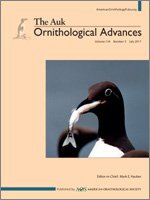In 1921, The Auk published an unresolved mystery submitted by Joseph Grinnell, founding director of the Museum of Vertebrate Zoology at the University of California, Berkeley. He had collected two Oak Titmice (Baeolophus inornatus) whose breast feathers appeared to be yellow; the feathers were covered in microscopic particles. He invited readers to further investigate the nature of these particles. Nearly a century later, we have determined that Grinnell's mysterious grains are willow (Salix) pollen, a diagnosis he rejected because the size of the particles had been mismeasured, and because he lacked a plausible explanation for how the birds would become coated in pollen. We investigated this case using Grinnell's own specimens, field notes, and correspondence, a testament to Grinnell's dedication to scientific rigor through carefully documented and curated natural history collections.
Joseph Grinnell, the great zoologist and ecologist, published an unresolved mystery in The Auk in 1921. In February 1920 his “son Willard, undertook to exercise the shotgun” and collected, from a stand of flowering willows (Salix), two Oak Titmice (Baeolophus inornatus) with striking yellow breasts (Grinnell 1921). Grinnell consulted prominent botanists and mycologists about the nature of the microscopic yellow grains stuck to the birds' otherwise gray breast and vent feathers. They rejected the hypothesis of willow pollen; it is generally 20–25 μm long, and they measured these grains as 6 μm long. Willow pollen morphology is otherwise consistent with Grinnell's description of the grains, but he concluded that they were perhaps from a profusely sporulating slime mold (Myxomycota) growing within the pair's roosting cavity. Grinnell finished his account by inviting the reader to continue investigation of the nature of the grains on these birds: “They, and their loads of spores, constitute Nos. 40,391 and 40,392 in the bird collection of the Museum of Vertebrate Zoology” (MVZ, University of California, Berkeley). Grinnell was the first director of the MVZ.
Ninety-seven years after their collection, we were kindly provided breast feather samples from nos. 40,391 and 40,392 by Carla Cicero of the MVZ. Three observers using two microscopes with calibrated eyepiece reticules measured the yellowish grains, still stuck to the feathers. The resulting measurements all fall in the range of 20–26 μm, consistent with willow pollen. Examination of the morphology of the grains by scanning electron microscope (Figure 1) confirms that Grinnell's titmice were yellowed by adhering willow pollen. Spores of myxomycetes, by comparison, are generally 5–15 μm in length (Tesmer and Schnittler 2007) and morphologically quite distinct.
FIGURE 1.
Environmental scanning electron microscope imaging of yellow grains adhering to feathers from Grinnell's Oak Titmouse specimens reveals that the propagules in question have all the standard characteristics of willow pollen: 20–25 μm long, prolate, with a pronounced margo across the major axis, and clearly defined muri and lumina on their outer surface. Positive identification as willow pollen was made using the palynology reference collection of the Hotchkiss laboratory, Department of Botany, University of Wisconsin–Madison.

Unpublished correspondence from 1927 (provided by MVZ archivist Christina Fidler) between Grinnell and mycologist Lee Bonar (UC Berkeley Department of Botany) demonstrates that Bonar reached the same conclusion. Grinnell remained skeptical, responding that “I cannot see how such a lot of pollen could have been acquired by the feathers of the extreme exterior lower surface, especially the anal tuft. For this reason, when it was suggested, I felt that the conditions were met by a material into which the bird might wallow, as when going to roost…in…a cavity of a tree trunk.”
Given the rarity of willow-pollen-covered bird undersides, how Grinnell's two birds achieved their adventitious coloration can still only be guessed at. Oak Titmice will use cavities in willows (Cicero 2000); these two could have used one cluttered with blown pollen or fallen catkins. An atypically early nest could have been lined with willow blossoms (locally abundant in February), rather than the more common oak blossoms (Cicero 2000), which are available starting in March (Fairley and Batchelder 1986). Bird nest collections, such as that started by Grinnell at the MVZ, tell us that both these scenarios would be possible but sufficiently unusual to explain why no other yellow-bellied Oak Titmouse has been reported.
Grinnell's dedication to carefully documented and curated natural history collections (including, in this case, birds, adherent pollen, nests, field notes, and relevant correspondence) allows the resolution of his mystery almost a century later. Nos. 40,391 and 40,392, and their loads of willow pollen, remain for further examination in the bird collection of the MVZ (Figure 2).
ACKNOWLEDGMENTS
We thank the staff of the Museum of Vertebrate Zoology for material, aid, and advice, the Hotchkiss Lab at the University of Wisconsin–Madison for palynological input, and S. Swanson and the Newcomb Imaging Center for help with electron microscopy.






